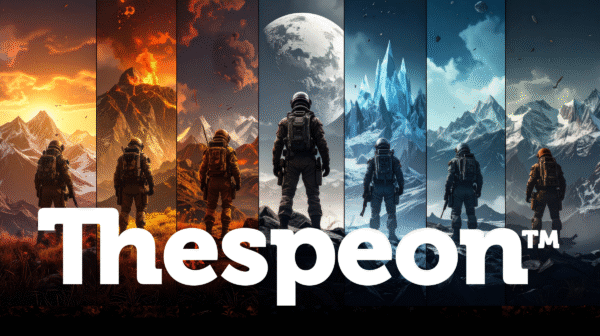Lingotion Thespeon is an on-device AI engine designed to generate real-time character acting and voiceovers. It introduces a new era of game design, where player characters, NPCs and voiceovers act and react dynamically based on the game state—eliminating the need for prerecorded audio files and animations.
Lingotion Thespeon, named after the ancient Greek actor Thespis, focuses on generating acting. While real-time, game-state-driven script dialogue can be procedurally generated—offering near-infinite interactive possibilities—true immersion requires expressive, AI-driven acting. The Lingotion Thespeon Engine brings procedural content to life with realistic, performance-efficient AI-Acting.
👆 Download the file to your computer, install and run!


A player enters a shop filled with various clothing items of different colors and picks up a green shirt.
The shopkeeper responds with interest:
“That green shirt would go perfectly with your brown trousers.”
But the response dynamically adapts based on the player’s outfit:
With simple logic based on the player’s actions and real-time game state—such as the color of the trousers and the item being picked up—a developer can generate countless manuscript variations with appropriate emotional tones.
This transforms the shopkeeper from a static, pre-recorded NPC into a responsive, emotionally aware character, delivering a more immersive and dynamic player experience.
And it all happens in real-time, directly on the player’s device—using only the local hardware with no cloud dependency, no usage costs, and works on all types of devices.
When voice acting and facial animations became possible in games, it quickly became clear that real actors were essential for creating lifelike characters. The way humans express emotions—through voice and facial expressions—is deeply ingrained in us, making authentic replication crucial for realistic game experiences.
However, relying on recordings severely limits interactivity since every possible response must be pre-recorded.
This is why modern AAA games have an overwhelming number of recorded lines. Yet, despite thousands of recorded voice lines, characters still feel repetitive, offering poor interactivity beyond the main gameplay. The challenge lies in the infinite ways players can interact with a game—something traditional recordings simply can’t accommodate.
Until now, the only alternative was simple text-to-speech and facial animation technologies, which delivered stiff, robotic performances that lacked emotional depth.
As a result, studios have been forced to choose between high-quality acting, animation, and realism—at the cost of interactivity, or fully interactive characters—at the cost of acting and animation quality.
Since neither option was ideal, studios were forced to prioritize acting quality over interactivity, making it the industry standard. But with Lingotion Thespeon AI-Acting Engine, studios now have a third option.
Lingotion Thespeon AI-Acting Engine runs on-device in real time on most gaming hardware, enabling full interactivity while still producing natural audio, facial animations, and acting of acceptable quality.
With Lingotion’s technology, the quality has now surpassed the “good enough” threshold, unlocking the potential for fully interactive characters—a breakthrough we call the Tomb Raider Effect.
The Tomb Raider Effect refers to the tipping point when technological advancements shift prioritization from quality to interactivity.
A prime example occurred in 1996, when 3D gaming reached a level where graphics were good enough to prioritize freedom of movement in a true 3D space.
One of the first major successes was Tomb Raider, which allowed players to explore a fully navigable 3D world. The game pushed the limits of 3D rendering on the hardware of its time, sacrificing graphical detail for interactivity.
The result? A low-polygon Lara Croft, but the unprecedented freedom to move in 3D space made the game a huge success, selling over 7 million copies—an impressive feat nearly 30 years ago.
The Tomb Raider Effect happens when technology reaches a tipping point where interactivity takes priority over absolute quality—because the overall experience becomes more valuable than pure audio/visual perfection.
Just as 3D gaming in 1996 reached a level where freedom of movement became more important than graphics quality, AI-Acting has now reached its own Tomb Raider Effect in 2025.
With Lingotion Thespeon AI-Acting Engine on-device, real-time interactive characters that truly act and respond dynamically are now possible—setting a new standard for non-linear storytelling in games.

Find the package here:
| Cookie | Duration | Description |
|---|---|---|
| cookielawinfo-checkbox-analytics | 11 months | This cookie is set by GDPR Cookie Consent plugin. The cookie is used to store the user consent for the cookies in the category "Analytics". |
| cookielawinfo-checkbox-functional | 11 months | The cookie is set by GDPR cookie consent to record the user consent for the cookies in the category "Functional". |
| cookielawinfo-checkbox-necessary | 11 months | This cookie is set by GDPR Cookie Consent plugin. The cookies is used to store the user consent for the cookies in the category "Necessary". |
| cookielawinfo-checkbox-others | 11 months | This cookie is set by GDPR Cookie Consent plugin. The cookie is used to store the user consent for the cookies in the category "Other. |
| cookielawinfo-checkbox-performance | 11 months | This cookie is set by GDPR Cookie Consent plugin. The cookie is used to store the user consent for the cookies in the category "Performance". |
| viewed_cookie_policy | 11 months | The cookie is set by the GDPR Cookie Consent plugin and is used to store whether or not user has consented to the use of cookies. It does not store any personal data. |